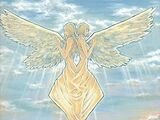| Goddess | |
|---|---|
 Runoa goddess | |
|
VIZ Media name |
Goddess[1] (en-us) |
|
Variant |
Göttin[2] (Goddess de), diosa[3] (goddess es-es), déesse[4] (goddess fr), dea[5] (goddess it), богиню[6] (goddess ru) |
|
Original name |
女神[7] megami |
|
Class |
Deity |
|
Description |
Female deity |
|
Status |
Extant |
|
Quote |
It's a statue of a goddess by Auguste. I've been told this is from the Runoa period.[8] |
|
Region |
Lautrec, Toulouse |
|
Locale |
Town of Hamel, Holy City of Rabona |
|
First mention |
Scene 5, Anime Scene 3 |
|
First appearance |
|
Etymology[]
女神 (megami) translates as "goddess." Father Vincent also uses the gender-free 神 (kami ).[9] Similar to the Sanskrit Deva.
Appearance[]
Only female gods have appeared in Claymore. They usually have wings.
History[]
Runoa goddess[]
Clare, impersonating an antiques dealer, has Raki display a statue of an unwinged, Runoa goddess.
Clare says the statue is from the "Runoa period" (ルノア時代) by Auguste (オーギュスト), possibly alluding to Auguste Rodin (1840–1917), French sculptor.[10]
Later, when the Voracious Eater tries to cut through the statue, a Claymore sword is revealed.[11]
Goddess of Rabona[]
The Goddess of Rabona first appears on the subtitle plate of tankōbon 2.[12] With sword in hand, she stands on a pile of demonic corpses. Similar to avenging angel.
The streamer she holds is the emblem of the Church of Rabona
Teresa and Clare[]
Twin goddesses of love. First mention by Teresa.[13]
In the town of Hamel, Clare discovers a Teresa and Clare statue in the village plaza.[14]
Additional details[]
The literary sources of religion in Claymore appear to derive from three sources:
- Goddesses from history: names of goddesses make frequent appearances as names of warriors. Goddess statues are stylized in the Classical Greek-Roman manner
- Catholic Church: names of saints make frequent appearances. The Church of Rabona resembles the Catholic Church, with similar rites like baptism. Also, the name of the Claymore mangaka—Norihiro Yagi—can be a Catholic or Protestant name in Japan
- Theosophy:[15] concepts like Yoma power and auras and the ability to sense them derive from Theosophy, which derives from the Hindu and Buddhist traditions. Writers that influenced Claymore-like genres—H. Rider Haggard, Talbot Mundy and L. Frank Baum—were themselves influenced by Theosophy
References[]
Tankōbon Claymore volumes cited are VIZ Media (en-us) editions, unless otherwise noted. Manga scenes (chapters) not yet translated cite Shueisha tankōbon (ja) editions. Manga scenes not yet published in tankōbon form cite Jump SQ (ja) editions. Fragments of Silver Omnibus (総集編 銀の断章 Gin no Danshou) 1–3, Shueisha, are only available in Japanese. Anime scenes (episodes) cited are FUNimation (en-us) editions, unless otherwise noted.
- ↑ Claymore 2, Scene 5, p. 10
- ↑ Claymore 2, Tokyopop, Scene 5, p. 10
- ↑ Claymore 2, Ediciones Glénat España, Scene 5, p. 10
- ↑ Claymore 2, Glénat Édition Française, Scene 5, p. 10
- ↑ Claymore 2, Tokyopop, Scene 5, p. 8
- ↑ Claymore 2, Comix-ART, Scene 5, p. 10
- ↑ Claymore 2, Scene 5, p. 10
- ↑ Claymore 2, Scene 5, p. 10
- ↑ Claymore 2, Scene 5, p. 23
- ↑ Claymore 2, Scene 5, pp. 10–11
- ↑ Claymore 2, Scene 9, p. 180–183
- ↑ Claymore 2, Shueisha, p. 3
- ↑ Claymore 3, Scene 14, p. 158; Claymore, Anime Scene 5
- ↑ Claymore 8, Scene 41, pp. 58–59; Claymore, Anime Scene 15
- ↑ Famous People and the impact of the Theosophical Society
All items (3)




